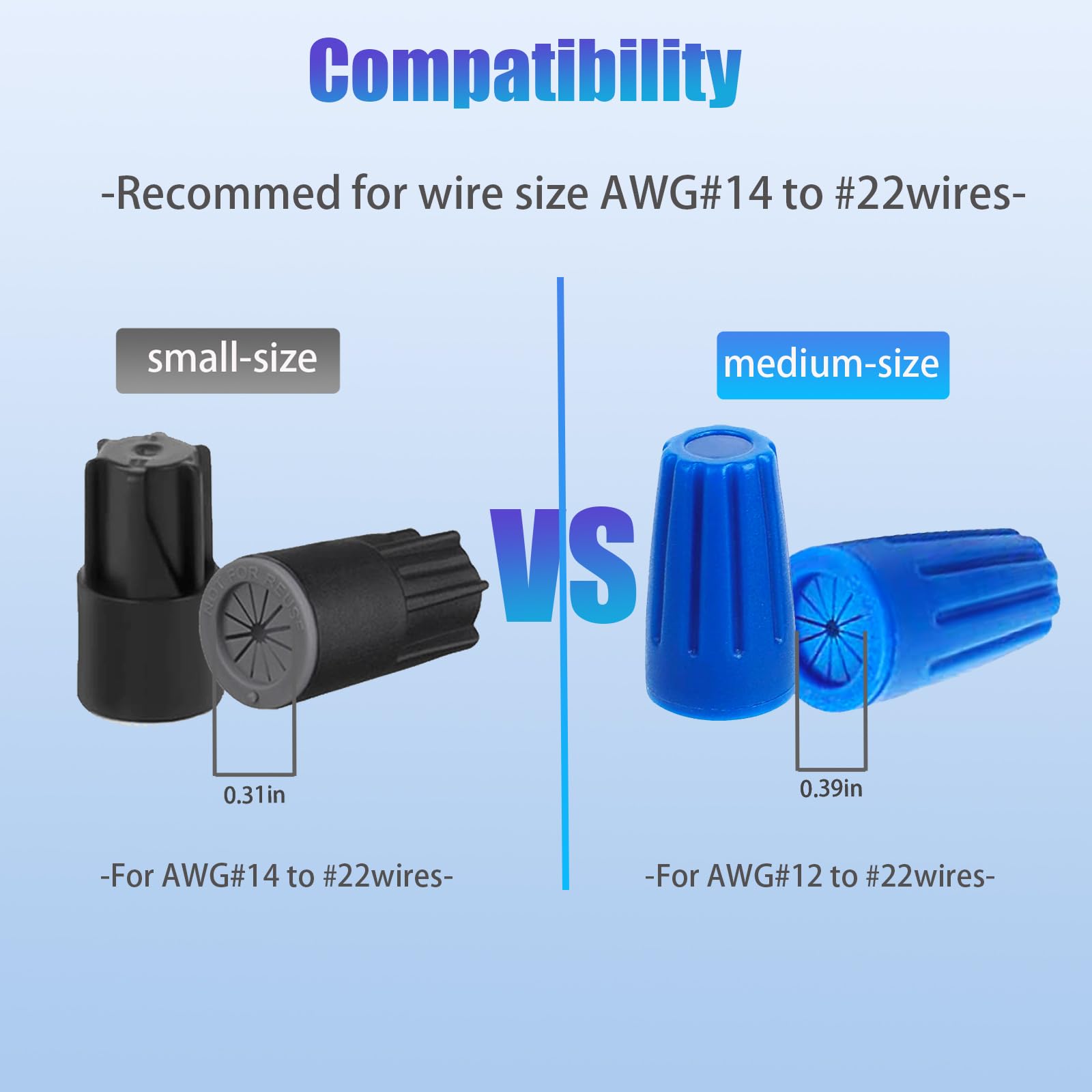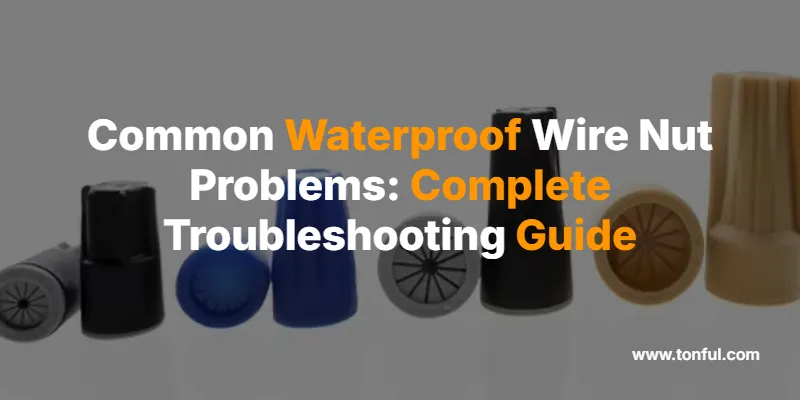Bottom Line Up Front: Waterproof wire nuts fail primarily due to improper installation techniques, wrong sizing, pre-twisting gel-filled connectors, and one-time-use violations. These failures create safety hazards including loose connections, arcing, and electrical fires.
Waterproof wire nuts are essential for outdoor electrical connections, but they present unique challenges that standard wire nuts don’t. When these specialized connectors fail, they can cause costly equipment damage, safety hazards, and code violations. This comprehensive guide identifies the most common problems and provides professional solutions to ensure your waterproof connections remain safe and reliable.
What Are Waterproof Wire Nuts?

Waterproof wire nuts are specialized electrical connectors designed with silicone sealant filling or gel-filled chambers that protect wire connections from moisture infiltration. Unlike standard wire nuts, these connectors create an airtight seal around electrical connections, making them suitable for outdoor applications and wet locations.
These connectors are critical for:

- Outdoor lighting systems – Deck, pathway, and security lighting
- Landscape wiring – Irrigation controls and garden lighting
- Wet location installations – Bathroom fans, basement circuits, garage electrical
- Pool and spa electrical – Any connections near water features
The 10 Most Common Waterproof Wire Nut Problems
1. Pre-Twisting Gel-Filled Connectors (Most Common Mistake)
Problem: Some gel-filled waterproof wire nuts should not be pre-twisted, as this prevents the gel from properly coating the conductors. Many manufacturers specifically state that pre-twisting is unnecessary and can cause failure.
Why This Happens:
- Electricians apply traditional wire nut techniques to gel-filled connectors
- Manufacturer representatives have specifically mentioned that wire nuts fail because people pre-twist the wires, preventing proper gel encapsulation
Solution:
- Always read manufacturer instructions before installation
- For gel-filled connectors: “Place stripped wires together with ends of insulation even. Twist connector onto wires pushing firmly until hand-tight. Pre-twisting unnecessary.”
- Let the connector do the twisting work
⚠️ Safety Warning: Pre-twisting gel-filled connectors compromises the waterproof seal and can lead to moisture infiltration and electrical failure.
2. Wrong Size Selection
Problem: Using a wire nut that’s too big or too small can cause your connection to fail, short circuit, or disconnect entirely.
| Wire Nut Size | Wire Gauge Range | Maximum Wires | Common Applications |
|---|---|---|---|
| Small (Gray/Orange) | 22-18 AWG | 2-3 wires | Low voltage lighting |
| Medium (Yellow) | 18-14 AWG | 2-4 wires | Standard lighting circuits |
| Large (Red) | 14-12 AWG | 2-5 wires | Heavy-duty outdoor circuits |
Sizing Problems Include:
- Too Small: Wire nuts that are too small may cause overheating and risk starting a fire
- Too Large: Connection feels loose and wires may slip out
Professional Selection Guide:
- Count the number of wires to be connected
- Identify the largest wire gauge in the bundle
- Check manufacturer specifications for maximum wire capacity
- Select the smallest wire nut that accommodates your requirements
3. Loose Connections Leading to Heat Buildup
Problem: Loose connections create high resistance, leading to heat buildup and potential arcing. Failing to properly tighten wire nuts is a common cause of electrical failures.
Warning Signs:
- Discoloration of the wire nut or a burning smell
- Flickering lights or intermittent power
- Warm or hot wire nuts during operation
- Wire nuts that have melted from loose neutral connections
Heat Buildup Causes:
- Inadequate tightening during installation
- Overloaded circuits with loose neutral connections under wire nuts can cause meltdown
- Corrosion increasing resistance over time
Professional Solution:
- Turn off power to the circuit immediately if overheating occurs
- Give wire nuts a gentle pull once installed to ensure everything is secure
- Verify proper wire engagement and retighten if necessary
4. Gel and Sealant Leakage
Problem: Silicone gel leaking out and users throwing connectors away due to messy applications
Common Causes:
- Over-tightening: Excessive force squeezes gel out of connector
- Temperature fluctuations: Gel melting out and running all over the place in a toolbox on a hot day
- Wrong connector type: Using gel-filled where grease-tube types are needed
Prevention Strategies:
- Twist connector onto wires pushing firmly until hand-tight. Do not over torque
- Store connectors in climate-controlled environments
- Wipe sealant in and around conductors and connector opening while tightening
5. One-Time Use Violations
Critical Safety Issue: Waterproof wire nuts are designed for one-time use only and should never be reused. The sealing properties deteriorate after initial installation, compromising moisture protection.
Why Reuse Fails:
- Gel or sealant becomes contaminated
- Internal threading loses grip strength
- Waterproof seal compromises permanently
Professional Practice:
- Always use new waterproof wire nuts for each connection
- Never re-use waterproof connectors unless you can refill them with the same grease first
- Budget for replacement during maintenance
6. Corrosion Despite Waterproof Rating
Problem: Electricians constantly finding waterproof wire nuts that are corroded and/or burned up in underground applications
| Application Type | Corrosion Risk | Recommended Solution |
|---|---|---|
| Direct burial | High | Use sealed connectors such as epoxy bags for underground applications |
| Above ground wet | Medium | UL-listed waterproof wire nuts |
| Submersion | Very High | Not for use in continuous submersion applications |
Corrosion Prevention:
- Verify that connectors have UV-resistant properties to prevent degradation from sunlight exposure
- Use appropriate IP-rated connectors for specific environments
- Coastal areas, industrial locations, or areas with chemical exposure may require specialized connector materials
7. Improper Wire Preparation

Problem: Proper wire stripping is crucial for secure connections. Incorrect strip length is one of the most common installation mistakes that can lead to connection failures.
Strip Length Guidelines:
- Small wires (22-18 AWG): Strip 1/2″ (12.7 mm)
- Medium wires (16-12 AWG): Strip 3/8″ (9.5 mm)
Common Stripping Errors:
- Under-stripping: Wire nut doesn’t properly grip copper
- Over-stripping: Exposed copper extends beyond connector
- Uneven cuts: Align any frayed strands or conductors
8. Overloading Beyond Capacity
Problem: Overloading wire nuts with too many wires can cause overheating and connector failure. Always check manufacturer specifications for maximum wire capacity.
Capacity Guidelines by Size:
| Connector Size | Maximum 14 AWG | Maximum 12 AWG | Applications |
|---|---|---|---|
| Small | 2 wires | 1 wire | Low voltage only |
| Medium | 3-4 wires | 2-3 wires | Standard circuits |
| Large | 4-5 wires | 3-4 wires | Heavy duty applications |
Professional Tip: Remember that the wire nut doesn’t make the connection, it holds the connection. You should twist your connection together first, then add the nut.
9. UV Degradation in Sunlight
Problem: Clear connectors are not intended for above ground use where they degrade in sunlight
UV Protection Requirements:
- Connectors protected with UV resistant materials
- Avoid clear plastic housings for outdoor applications
- Consider protective enclosures for long-term exposure
10. Code Compliance Violations
Problem: Using standard wire nuts in wet locations or waterproof connectors in inappropriate applications can lead to code violations and safety hazards.
NEC Requirements:
- NEC requirements apply equally to outdoor and indoor installations, with specific provisions for wet location applications
- Waterproof wire nuts must be UL-listed for their intended use
- Wire connectors that are listed for wet locations are permitted by the code
Step-by-Step Troubleshooting Process
Initial Safety Assessment
- Turn off power at the circuit breaker
- Test circuits with non-contact voltage tester
- Inspect visually for obvious damage or overheating
Diagnostic Checklist
| Problem Indicator | Likely Cause | Immediate Action |
|---|---|---|
| Melted/discolored nut | Loose connection/overheating | Replace immediately |
| Gel leakage | Over-tightening/wrong type | Clean and replace |
| Intermittent power | Loose connection | Retighten or replace |
| Corrosion visible | Moisture infiltration | Replace with higher-rated connector |
Professional Repair Process
For Loose Connections:
- Straighten the wires and retry twisting them together, ensuring they interlock properly, then reattach the wire nut securely
- Perform pull test to verify security
- Follow manufacturer instructions for twisting wire nuts. Pre-twisting wires can lead to a more reliable joint
For Overheating Issues:
- Immediately disconnect power to the circuit and inspect the connections
- Ensure you’re using the appropriate size and type of wire nut for the application
- Replace any damaged components before restoration
Selection Guide for Different Applications
Outdoor Lighting Systems
- Requirement: UV-resistant, gel-filled connectors
- Size: Match to wire gauge (typically 14-12 AWG)
- Features: Can withstand a 600 volt surge
Irrigation and Landscape Wiring
- Requirement: UL 486D Listed as a sealed wire connector system for use in damp, wet, raintight, and submersible locations
- Size: Small to medium (22-14 AWG typical)
- Features: Direct burial rated where applicable
Pool and Spa Electrical
- Requirement: GFCI-compatible, marine-grade sealing
- Size: Per circuit requirements
- Features: Residential outdoor circuits typically require GFCI protection, and waterproof wire nuts must be compatible with GFCI-protected circuits
Expert Tips for Long-Term Reliability
Installation Best Practices
- Leave a good length of extra wire, and tie off with a zip tie about 3in. back from connection to relieve any strain
- Apply the sealant generously around the wires and inside the connector to create a reliable seal
- Twist conductor connections together (aka “Cold Soldering”) with pliers before applying wire nuts to help avoid problems
Maintenance Schedule
- Annual Inspection: Check accessible outdoor connections for signs of moisture intrusion, corrosion, or mechanical damage
- After Severe Weather: Inspect all outdoor electrical connections following storms, flooding, or extreme temperature events
- Replacement Indicators: If you observe deterioration, discoloration, or if the connection feels loose during inspection, it may be time to replace the wire nut
When to Call a Professional
Contact a licensed electrician immediately if you encounter:
- Burned or melted connectors – Indicates serious electrical fault
- Repeated failures – May indicate underlying wiring problems
- Code compliance questions – Local building codes may have additional requirements beyond the NEC
- High-voltage applications – Professional expertise required for safety
Frequently Asked Questions
Q: Can I pre-twist wires before using waterproof wire nuts?
A: It depends on the type. Some gel-filled waterproof wire nuts should not be pre-twisted, as this prevents the gel from properly coating the conductors. Always consult manufacturer instructions.
Q: Why do my waterproof wire nuts keep failing?
A: One of the manufacturers of wet location wire nuts said that they fail because people pre-twist the wires, preventing proper gel encapsulation of conductors.
Q: Can I reuse waterproof wire nuts?
A: No. Waterproof wire nuts are designed for one-time use only and should never be reused. The sealing properties deteriorate after initial installation.
Q: What size wire nut do I need for my project?
A: You must use the proper wire nut that fits your wire gauge. Using a wire nut that’s too big or too small can cause your connection to fail, short circuit, or disconnect entirely.
Q: Are waterproof wire nuts suitable for underground use?
A: Many electricians find waterproof wire nuts corroded and burned up in underground applications. For true underground use, sealed connectors such as epoxy bags should be used.
Q: How do I know if my connection is secure?
A: Give it a gentle pull once installed to ensure everything is secure. A good practice is to verify that the wire nut is securely threaded onto the connection.
Q: What should I do if I smell burning around wire nuts?
A: If overheating occurs, immediately disconnect power to the circuit and inspect the connections. Symptoms of overheating include discoloration of the wire nut or a burning smell.
Q: Can I use regular wire nuts outdoors with tape?
A: No. You cannot tape up a wire nut that is not listed for a wet location and install it in a wet location. Use only UL-listed waterproof connectors.
Bottom Line
Waterproof wire nuts require specific installation techniques, proper sizing, and strict adherence to electrical codes to ensure safe, long-lasting connections in wet environments. Skipping these precautions can lead to connection failures, arcing, and serious safety hazards. The most critical factors for success are reading manufacturer instructions, avoiding pre-twisting gel-filled connectors, using proper sizing, and never reusing one-time-use connectors.
By understanding these common problems and following professional installation practices, you can ensure your waterproof electrical connections remain safe, code-compliant, and reliable for years to come. When in doubt, always consult with a licensed electrician to ensure your installations meet local codes and safety standards.

